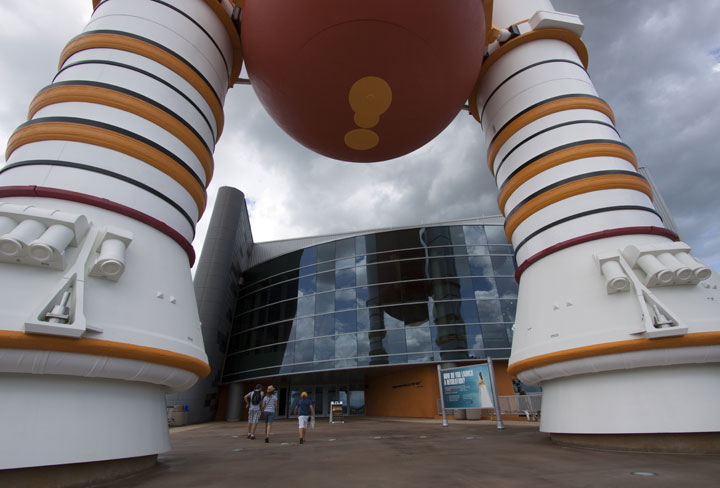CAPE CANAVERAL, Fla. – The last space shuttle to soar makes its museum debut this weekend, and it’s the belle of NASA’s retirement ball.

The Atlantis exhibit opens to the public Saturday at Kennedy Space Center, the centerpiece of a $100 million attraction dedicated to the entire 30-year shuttle program.
For the first time ever, ordinary Earthlings get to see a space shuttle in a pose previously beheld only by a select few astronauts.
Tilted at a deliberate angle of 43.21 degrees — as in 4-3-2-1, liftoff — Atlantis is raised in feigned flight with its payload bay doors wide open and a replicated robot arm outstretched.
Toss in a life-size replica of the Hubble Space Telescope and astronaut-captured images of the International Space Station beamed on the wall, and the impact is out-of-this-world.
More than 40 astronauts who flew on Atlantis planned to take part in Saturday’s grand opening at the visitor complex, a popular tourist attraction an hour’s drive due east of Orlando.
Retired astronaut Bob Springer got a sneak preview last week and liked what he saw. He rode Atlantis into orbit in 1990 – one of its 33 missions from 1985 to 2011.
“It’s awesome what they’ve been able to do,” Springer said.
So many museum displays are static and cold, he noted.
“This is exactly the opposite. It’s like seeing a wild animal in its native habitat. It really looks like you’re looking at Atlantis from an astronaut’s vantage point in space.”

Get daily National news
Only a small group of astronauts have seen Atlantis like this in orbit – those out on a spacewalk or those aboard a space station watching Atlantis come and go.
It makes this perspective – in flight in orbit – all the more riveting.
A family visiting from Karlskrona, Sweden, lucked out last week, among a limited number of tourists granted early access as part of a trial run for the exhibit.
“Amazing,” said Peter Trossing, accompanied by his wife and two young daughters.
“Pretty cool,” added Cincinnati’s Amanda Cook as her two sons tried out the space station toilet display. Children lined up to pose for pictures on the space potty mock-up.
Another hands-on draw for the younger set: two main landing gear tires used on Atlantis’ final touchdown on July 21, 2011. One after another, children spun the tires, which were mounted on a low pedestal.
Retired for two years, Atlantis is the last of NASA’s three space shuttles to go on public display.
Discovery is parked at a Smithsonian Institution hangar in Chantilly, Va. Endeavour is also horizontal at the California Science Center in Los Angeles; it will be displayed upright in launch position once its permanent exhibition hall is completed in 2018.
And the prototype Enterprise rests atop the Intrepid Sea, Air and Space Museum in New York City. The exhibit was closed following damage caused by Superstorm Sandy last fall; the new pavilion opens in two weeks.
Unlike its sister ships, the 155,000-pound Atlantis — tilting to the port, or left, side — has its nose 30 feet off the floor, its right wing 62 feet up and its left wing 7 feet up. Visitors can walk underneath and gaze up at its belly and the thousands of thermal tiles, and all the way around.
Towering over the outside entrance is a full-scale model of a shuttle external fuel tank paired with two booster rockets, 184 feet tall just like for launch. Inside are an authentic shuttle main engine (the three engines on Atlantis are facsimiles), astronauts’ spacewalking tools, the so-called beanie cap that covered the tops of space shuttles on the launch pad, as well as numerous interactive exhibits showcasing the phases of flight.
The display does not ignore the NASA’s two lost shuttles — Challenger, destroyed during liftoff in 1986, and Columbia, shattered during descent in 2003. In fact, the short movie viewed before entering the Atlantis gallery pays special homage to NASA’s first shuttle flight, by Columbia, in 1981.
The so-called “reveal theatre” ends with Atlantis appearing right before the guests.
“You want an emotional connection and you want that wow factor, and it delivers on both of those,” said Tim Macy, director of project development and construction for Delaware North Co., which operates Kennedy’s visitor complex for NASA.
Delaware North nabbed Atlantis in a high-stakes national competition two years ago. Kennedy was considered a shoo-in by many, given all 135 shuttle flights began here and most ended here as well.
A six-story structure was built to accommodate Atlantis. The fourth and final wall was erected once the shuttle was towed inside last November.
“It’s a doggone big building, and it really tells the shuttle story in an amazing way,” said William Moore, chief operating officer of the visitor complex.
Delaware North hopes to recoup some of its $100 million outlay through increased ticket sales. The Atlantis exhibit is included in the ticket price for the visitor centre: $50 for adults; $40 for children ages 3-11.






Comments